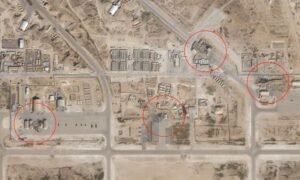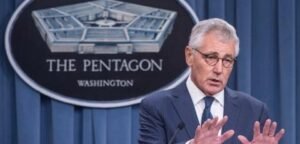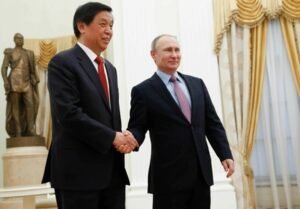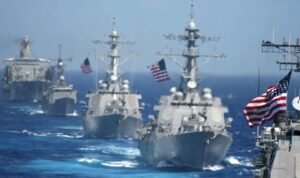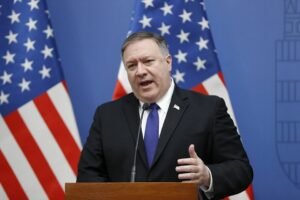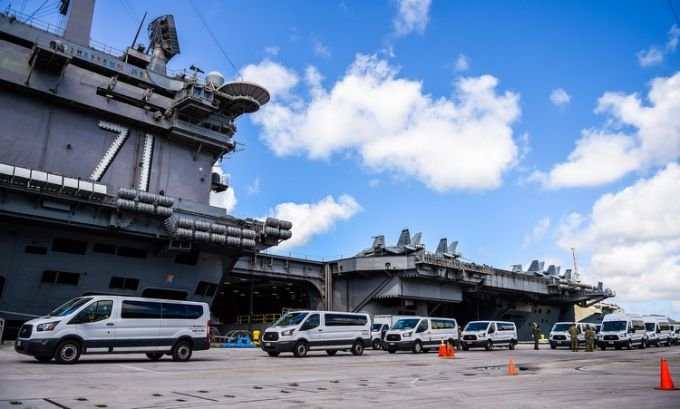
Two challenges for the US military in Asia 3
The situation did not seem to be positive for the US Navy in early May, when Chief of Staff Mike Gilday had to self-quarantine because of contact with a family member infected with nCoV, the aircraft carrier USS Theodore Roosevelt and the destroyer USS
USS Ronald Reagan, America’s only forward-deployed aircraft carrier, also had to deal with a series of nCoV infections while stationed in Japan.
Experts say that the US Navy in particular and the US army in general are facing many challenges when responding to Covid-19, while still having to maintain a significant military presence in the Asia-Pacific.
USS Theodore Roosevelt in Guam after the outbreak of Covid-19.
US Defense Secretary Mark Esper earlier this month announced that Covid-19 had `hardly had a significant impact on combat readiness` of the US military, but also warned of a `larger impact` in the long term if
It is currently unclear how many US soldiers have Covid-19 in the Indo-Pacific region, because the Pentagon requires bases and combat commands not to disclose data to ensure security.
According to experts, although the US military can recover very quickly after the pandemic, regional allies are still skeptical about the US commitment under President Donald Trump and worry that China may find a way to fill the gap.
`There is certain concern in Japan about the US military’s combat readiness due to the pandemic,` Collin Koh, a scholar at Singapore’s S. Rajarnatnam School of International Studies, opined.
According to Koh, with its position as a regional power and influence in the Indo-Pacific, Japan will have to act soon to shoulder the role when the US military has problems with combat readiness.
While Washington and Beijing are engaged in a war of words about the origin of nCoV and how to respond to the pandemic, Chinese media has actively propagated the hypothesis that the US military is trying to hide its weakened position due to the epidemic.
`Recent topics in Chinese state media are all aimed at sending the message that the US military is in trouble with the pandemic, they are being abandoned by politicians in Washington because the administration of President Donald Trump is busy handling it.`
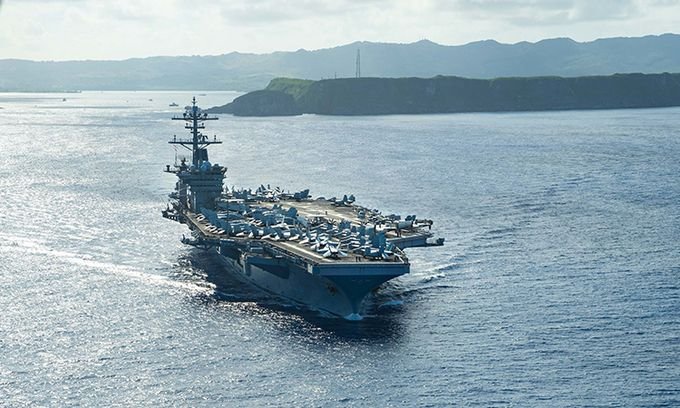
USS Theodore Roosevelt left Guam on duty on May 20.
Meanwhile, observers are also skeptical of the Chinese military’s claim that it has not recorded any cases of nCoV infection among its two million active troops.
`It is difficult to believe that their combat readiness is not affected by nCoV. The Chinese military may be trying to hide challenges with combat capabilities by presenting a strong external image,`
In addition to promoting propaganda in the media, China also continues to increase aggressive activities in the East China Sea, the East Sea and the area near the island of Taiwan.
Chinese coast guard ships in early May chased Japanese fishing boats near the disputed Senkaku/Diaoyu Islands and were continuously present here for the first time for three consecutive days since 2016.
In the past month, the Chinese navy also conducted live-fire exercises to enhance `combat capabilities`, while the Haiyang Dizhi 8 geological survey ship was deployed to the southern region of the East Sea, near the location.
US Deputy Assistant Deputy Secretary of Defense in charge of Southeast Asia Reed Werner said on May 19 that Chinese fighter jets have harassed US reconnaissance aircraft at least 9 times over the East Sea since the end of March, when
Werner also accused China of `harassing` the destroyer USS Mustin when it operated near the Chinese aircraft carrier strike group passing through the East Sea in April. He said during this encounter, a ship
Although allies are concerned about the US military’s combat readiness, there are many signs that the country is still capable of maintaining a stable military presence in the region.

B-1B bombers practice with US F-16 and Japanese F-2 fighters on April 22.
The US Navy continuously conducts freedom of navigation patrols near artificial islands occupied and illegally renovated by China, and deploys the amphibious assault ship USS America carrying F-35B stealth fighters.
The US Navy’s Pacific Fleet made a surprising move earlier this month when it announced that the entire forward submarine fleet was simultaneously performing `emergency response activities` in the waters of the Western Pacific, in
`These public moves are clearly intended to respond to China’s propaganda campaign, demonstrating that US military strength in the Western Pacific region is not diminished,` Olli Suorsa, scholar at the School of National Studies
`While allies and partners may be very worried about the US presence in the region, so far there is no sign that the US is reducing its commitment. On the contrary, the US military seems to be increasingly concerned about
